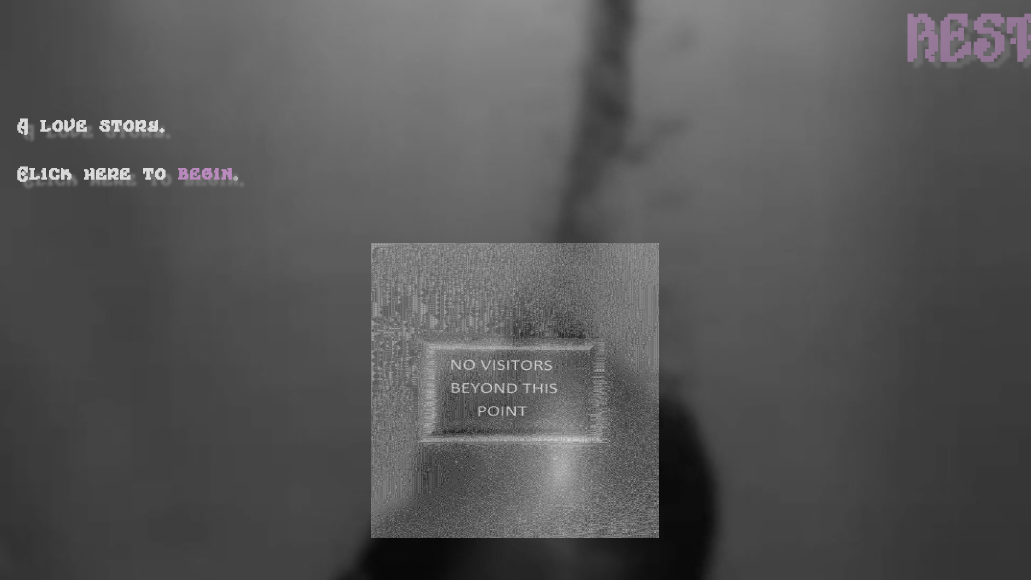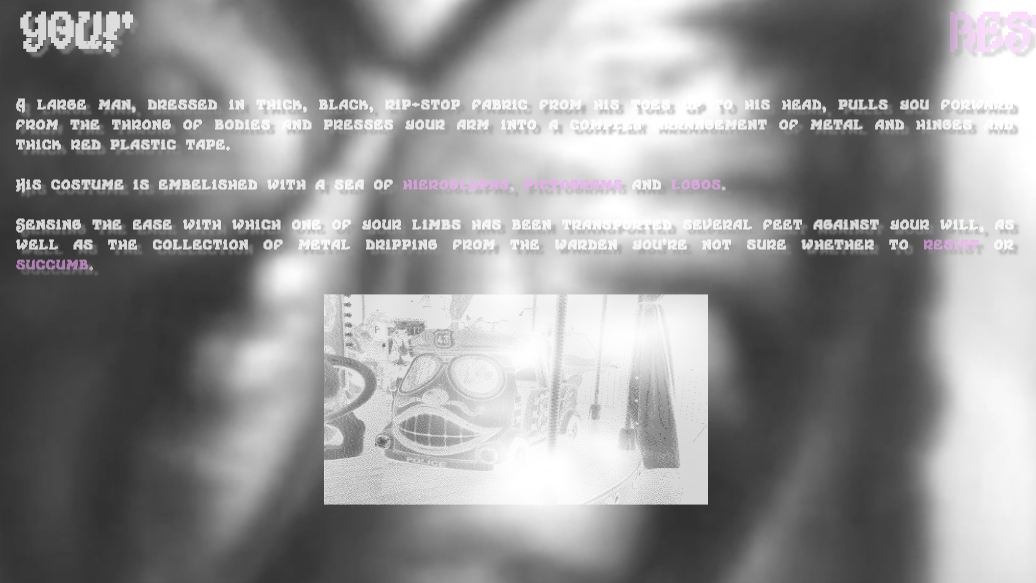Basma Lord's Visions
Nilson Carroll
I stumbled into Peter Basma-Lord’s intermedia game poetry on Twitter a few months back. His site boasts an impressive array of indescribable works that teeter between installation, machinima, text adventure, and dream-incantation. Perhaps teeter isn’t the right word, as that evokes an unsteady balance between boundaries on a scale.
In Basma-Lord’s visions, there are no boundaries.

Basma-Lord’s G4S is a Twine interactive fiction art installation, that fuses text, still image, and moving image into a murky, unreal surface of interaction. Immediately striking in the web browser is the formless gray matter shifting in the background, often obscuring the white text, the body of the narrative. Our expectations of simply seeing the text are disrupted.
By the end of the initial text passage, an abrupt and violent physical encounter with a giant man cloaked in black, players are given two options, to “resist” or “succumb.” The option here does not matter, as either choice leads the player character down a series of increasingly narrow passageways and through oppressive pits. Interactions with dystopian machinery, endless synthetic environments, and impossible, poetic spatial relationships (gifts from the artist) serve to disorient and force the player forward.
You are in the middle of a lake of grey water.
You are sitting on the face of a politician.
The current is pulling you towards the opposite bank.
Throughout, G4S recalls the RPGMaker 2003 game OFF, an imperialist set of zones structured by unknown, ersatz systems for the player to grovel through. Somewhere in our DNA, the blood pumping through the veins of the alternative game-poet, we know this oppressive place devoid of life, feel it in the decades of struggling with the symmetry of Mario, in murdering hapless, grinning slimes for points in Dragon Quest. G4S is a questioning and rejection of the strategies of gameplay and narrative at large.
As players move between claustrophobic warehouses, searching for an escape, the gray abstract fluid in the background constantly obstructs the text, blocking one’s view until it decides to flow away, or turn black. A player may find her nose increasingly close to the monitor, eyes all screwed up.
Hidden within the narrative text are clues which shed light (if recognized) on three adjacent videos inside the overall physical installation of the piece. Another layer of clues inside the videos reveal a series of numbers to an attached combination lock, which binds a “trophy” within a cage.
Surfaces, both digital and physical, collide and collapse: plastic barriers, monitor screens, dead-ends, immutable HTML, and cage walls. This is the content of the work.

Basma-Lord succeeds in transcending medium, erasing the dividing lines of disparate forms while keeping the player firmly stuck, trapped. Poetry reader (who cut her teeth on parsing modernist poetry for meaning) transforms into game player, puzzle solver (learned behaviors from Myst, Zoombinis, howling dogs), is then broken down into imprisoned mush before ascending to liminal interactor, agent of expanded cinema.
Unsure of where to go or what to do,
surrounded by fences & shipping containers
and emptied of anything of worth,
you sit on the ground.
At the end of the game narrative, the player character is disposed of, or maybe transposed into the player, who must either gain access to the interior of the cage or give up and walk away. The choice is no longer “resist” or “succumb,” but closer to “be” or “cease being,” an ancillary option to the far more prevalent and understood “win” or “lose.” But like Basma-Lord’s initial offer of choices, does our binary answer ultimately matter, a minor gesture in an infinite void?
*
Nilson Carroll is an MFA candidate at Visual Studies Workshop in Rochester, NY. A barista-poet, Nilson is currently exploring 16mm expanded cinema, video projection performance, and makes queer video game installations.